5 Epic Product Descriptions (& How to Copy Them!)
Quick question: When was the last time you purchased something online? Yesterday? This morning? Ok, cool. So when do you think you’ll next purchase something online? Tomorrow? Tonight? No shame—me too.
And we’re not alone. Last year, 80% of Americans shopped online at least monthly, and 5% were shopping online daily, Big Commerce reported. For many of us, online shopping has become a routine part of daily life, with huge impact on a global scale. Global ecommerce sales have skyrocketed over the last four years: According to Statista, in 2014, annual online sales totalled $1.3 billion USD worldwide; by last year, they’d doubled to $2.8 billion; and by 2021, they’re expected to nearly double again to $4.48 billion. That’s 17.5% of retail sales worldwide.
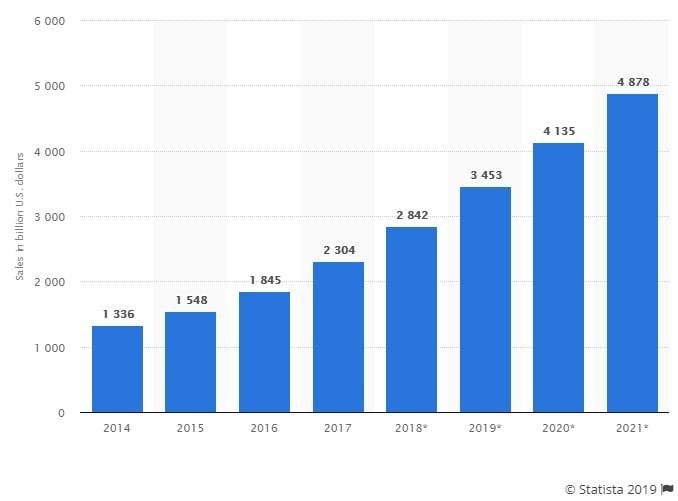
Via Statista
Bottom line? Ecommerce is big and getting bigger. And navigating the ever-changing ecommerce terrain is a big challenge for small businesses used to the brick-and-mortar paradigm. So many factors impact your success online: how familiar people are with your brand, how effectively your Google Display ads are raising awareness, whether or not you offer fast and free shipping, how frequently your potential customers abandon their carts, and more.
But with these challenges also come opportunities. Let’s focus on just one for now: your product descriptions. In this guide:
- I’ll break down why your product descriptions are an incredible opportunity to engage your potential customers
- I’ll share five examples of insanely effective product descriptions
- And I’ll explain how you can use these product description strategies for your own ecommerce business.
Let’s go!
Ready to drive more traffic to your product pages than ever before? Download our free guide to advertising on Google Shopping!
Product descriptions let you put your customers first
If you’ve been reading this blog for a while, you’ve probably seen at least one of our customer spotlights. We love our customers! As a former small business marketer myself, I love our passionate dedication to empowering and supporting small business growth.
For your business, too, your customers’ wins are your wins. If you’re a small retailer, this is true not just with your in-store customer service, but also your ecommerce website’s overall UX, its check-out flow, your online return options, and your product descriptions. By writing accurate, educational, and engaging product descriptions, a copywriter serves their customers just as much as a sales associate does when someone walks through your shop’s front door.
In fact, your product description is arguably your best opportunity to provide the heart and soul of that in-store experience for online shoppers. It’s also your chance to snag prospects who research online before buying in-store, as do a whopping 81% of retail buyers.
Don’t worry—you don’t need to be a brilliant copywriter to write product descriptions that work.
You just need to keep your customer first. Not sure how? Here are five examples of epic product descriptions that you can learn from and use as inspiration.
1. Turn features into benefits
Want a superweapon to ignite your customer’s interest in a product? It’s right under your nose: Take your product’s unique features and turn them into benefits.
What are features and benefits? Think about what gets you excited about your product that makes it different from your competitors’ products. It might be careful construction, ethically sourced materials, or all the bells and whistles you dreamed up over drinks one night. Those are features.
Now, think about what those things do for your customer. Does careful construction mean that your product is safe for children? Do ethically sourced materials make the buyer feel good about purchasing your product? Do those bells and whistles make everyone who sees your customer with your product weep with envy? Those are benefits.
In product descriptions, it’s easy to fall into the trap of only describing the features of your products. But when you just list the features, you’re not actually helping your buyer understand how your product will help them.
Let’s talk about a product page that communicates both features and benefits effectively.
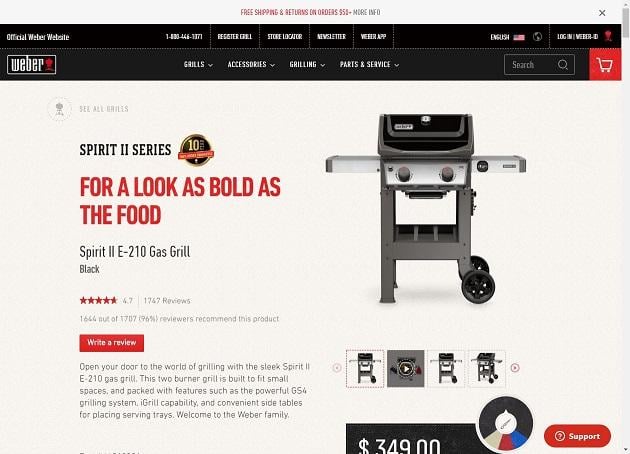
Via Weber
Here’s the product description:
Open your door to the world of grilling with the sleek Spirit II E-210 gas grill. This two burner grill is built to fit small spaces, and packed with features such as the powerful GS4 grilling system, iGrill capability, and convenient side tables for placing serving trays. Welcome to the Weber family.
Bias alert: I kind of want this. My husband and I love summer, and we love burgers. But we’re urban apartment dwellers with no space for a BBQ.
The product description for this grill speaks to the target market (me!) by expressing how its main features address my need for a grill that can squeeze into a tiny balcony space.
| Feature | Benefit |
| “Sleek…two-burner grill built for small spaces” | “The perfect size to grill up a couple of burgers for everyone in the family” |
| “Convenient side tables…” | “…for placing serving trays” |
| “Packed with [branded] features” | “Welcome to the Weber family” |
See how the copy addresses the same primary buyer need multiple times? They’re well aware that my main concern when shopping for a grill is its size, and that if I’m not convinced that the grill will fit in my space and do a good job, I won’t buy it. The product description repeats that the grill is small and has side serving trays (features) to maximize my small space while making enough food for everyone (benefit).
And see the last example, in italics? The copywriter also knows that I have both practical needs and emotional ones. In this case, they’re assuming that, like many other urban millennials, I grew up in a suburban environment and desire a neighborhood-like community. Welcoming me into the Weber family if I purchase the grill fills that desire—a compelling benefit, if an abstract one.
⚡️ Free guide download >> PPC 101: Complete Guide to Google Ads
How to turn your features into benefits
To get started writing features and benefits for your products, ask yourself some questions:
- Who’s your target buyer?
- What does that person need?
- What do they want?
- What are their pain points?
Those answers will help you get started on a strong product description that turns features into benefits—and potential customers into buyers.
2. Anticipate your buyer’s pain points
You know what I want even more than a BBQ? A puppy. A snuggly, cuddly, floppy-eared little puppy.
But you know why I don’t have a puppy? They’re such a pain. They’re expensive, they bark at stuff, they pee on the floor, and they chew—on everything.
Guess who knows that? The people at KONG. Check it out.
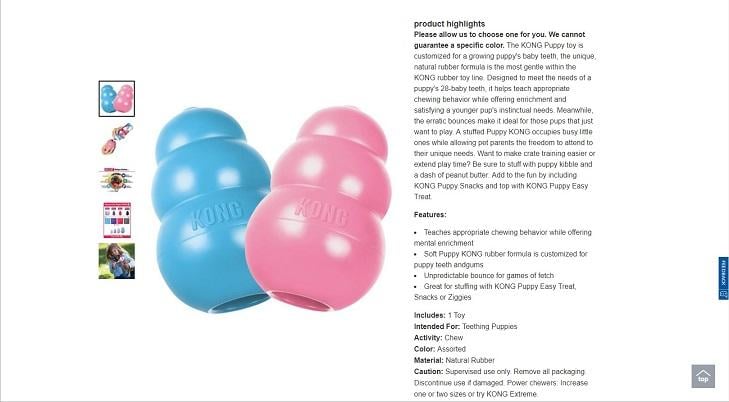
Via PetSmart
Here’s the product description:
Please allow us to choose one for you. We cannot guarantee a specific color. The KONG Puppy toy is customized for a growing puppy’s baby teeth, the unique, natural rubber formula is the most gentle within the KONG rubber toy line. Designed to meet the needs of a puppy’s 28-baby teeth, it helps teach appropriate chewing behavior while offering enrichment and satisfying a younger pup’s instinctual needs. Meanwhile, the erratic bounces make it ideal for those pups that just want to play. A stuffed Puppy KONG occupies busy little ones while allowing pet parents the freedom to attend to their unique needs. Want to make crate training easier or extend play time? Be sure to stuff with puppy kibble and a dash of peanut butter. Add to the fun by including KONG Puppy Snacks and top with KONG Puppy Easy Treat.
Features:
- Teaches appropriate chewing behavior while offering mental enrichment
- Soft Puppy KONG rubber formula is customized for puppy teeth andgums
- Unpredictable bounce for games of fetch
- Great for stuffing with KONG Puppy Easy Treat, Snacks or Ziggies
This does a wonderful job of addressing the problems, needs, and worries of new pet parents. Here are three great examples from the copy.
Pain point: My teething puppy is chewing everything!! I’m afraid she’ll eat the whole house and hurt herself in the process.
| Feature | Benefit |
| “Unique, natural rubber formula” | “Teaches appropriate chewing behavior” |
Pain point: Help! My puppy has too much energy!
| Feature | Benefit |
| “Erratic bounces” | “Allows pet parents the freedom to attend to their unique needs” |
Pain point: How do I train my super-smart puppy to be a well-adjusted adult dog?
| Feature | Benefit |
| “Erratic bounces” | “Offers mental enrichment” |
The copywriter addresses multiple buyer pain points by pulling a ton of benefits out of just a few features. Pretty cool, right?
How to address pain points
To use this method in your product descriptions, you need to identify pain points. Got repeat customers? Send them a survey asking them why they bought your product and why they keep buying. Ask questions designed to draw out some of the ordinary problems they face every day. Got customer reviews? Peruse them to find common threads around your product solving the buyer’s problem.
For bonus points (see what I did there?), check out Chewy’s description for the exact same KONG product. Map out how that copywriter addresses the buyer’s pain points, describing the same features and benefits in a slightly different way.
Sound good? Great. Let’s keep going.
📚 Free guide download >> 135 of the Best Words & Phrases for Marketing with Emotion
3. Make your buyer smarter
Your job on the product page is to educate your customer. Write detailed, informative copy that helps your customer make a smart purchase decision.
How much information they’ll need depends on the company and the product. If you’re a well-respected brand, your customers are mostly repeat buyers, or your price point is very low, you’ll need to include less information. But if you’re a small, lesser-known brand in a high-competition industry, you’ll need to provide a ton of information to make your customer feel confident in their purchase.
Most small retailers fall into this latter category, where more information really is more. Here’s an example.
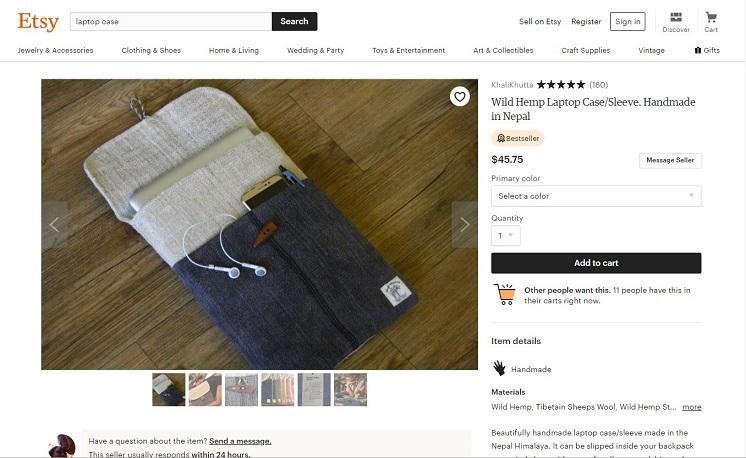
Here’s the product description:
Beautifully handmade laptop case/sleeve made in the Nepal Himalaya. It can be slipped inside your backpack or carried alone with space for all your work bits and pieces!
Designed and measured to fit a 12″ to 14″ laptops and with a convenient front pocket for your charger cable and notebook. We can also make you a custom sized and coloured sleeve to fit your laptop/macbook or tablet. Get in touch for details.
Hemp grows wild throughout Nepal and has long been used to create fabrics used in clothe making etc. You can now own a piece of this ancient tradition in the form of a functional, stylish laptop case.
Design Details:
The main pocket (where your laptop goes) as well as the top flap, are made with wild hemp, harvested, spun and handwoven here in Nepal.
The inside has Tibetain sheeps’ wool for an effective, natural and sustainable padding (instead of chemical based neoprene used in most cases).
The smaller, front pocket uses recycled wild hemp cloth – from bags used by farmers from rural Nepal. This is slightly thinner than the other wild hemp fabric in this item and because of its past use is beautifully soft. This front pocket can accommodate your laptop charger as well as a note book/pens etc. making it super convenient.No Chemicals or Chemical Dyes
We use only natural plant/mineral based dyes.
We use no bleach or other chemical treatments or dyes in our production process.
The fibres are hand-harvested, washed in pure Himalayan water and hand-spun, weaved and stitched.SUPPORTING RURAL LIVELIHOODS IN NEPAL
We work with a small group of Nepali handcrafters and local communities harvesting wild fibres to bring you these yoga accessories. We support rural livelihoods and cottage industries in Nepal by providing a wider market for their produce to help continue traditional skills and indigenous knowledge. By buying this item you are helping to support rural farmers in Nepal.We do not mass-produce any of our range, but operate a batch process system. This means that all our items are made with that bit more care and love – and you can see that in the finished item!
If you search for “laptop case” on Etsy, you’ll get upwards of 54,076 results. Handcrafted leather, all-recycled materials, faux marble, faux wood, cork—if you can think of a material, you’ll probably find a laptop case made out of it here. So why would you choose any of these, let alone this item in particular, which is an Etsy bestseller? You’d pick one because it’s the right size for your laptop, and you like how it looks. But if you’re an Etsy shopper, you likely also care about how the case was made, where the material came from and who did the labor.
The product description for this laptop case is 393 words long, but it doesn’t waste any time delivering the key selling points: The product is handmade in Nepal ( emotional need), and it can fit in a backpack or be used alone (practical need).
The copywriter spends the rest of the description blowing out these two main points. Where it really shines is the explanation of how the traditional materials aren’t just beautiful, but are also practical. Who would’ve thought that Tibetan sheep’s wool would be such a good cushion to protect a laptop? Or that the traditional weave of the hemp would keep the case light and easy to carry? Talk about educating your buyer!
How to educate your potential customer
Take some time to think through the likelihood that your target buyer has:
- Purchased from you previously?
- Purchased this item previously, or a similar one, from another retailer?
- Researched the item before hitting your product page? (Check Google Analytics to see where your traffic is coming from. It might yield some interesting insights.)
- Any knowledge about the best practices for creating this product? If not, would they like to learn?
4. Tell a story
Who doesn’t love a good story? Bedtime stories, ghost stories, war stories, tragic star-crossed lover stories, that-awkward-thing-I-got-mocked-for-in-middle-school stories. Telling stories, both to ourselves and others, is part of what makes us human. It’s also a powerful marketing tool, especially for your product descriptions.
This description below does so much more than introduce a backpack and explain how many items it can hold. It tells (you guessed it) a story.

Via ThinkGeek
Here’s the product description:
ENDOR COMMANDO
- Officially-licensed Star Wars merchandise
- Sometimes blending in is the best plan
- Big enough for your Ewok BFF
Pack it up! We’re deploying to Endor in the morning, and you need to find a bag big enough for the essentials with extra space for a small teddy-bear like lifeform. Hypothetically. We’re not telling you to take an Ewok back with you, but… if you find your Ewok BFF, you’ll have the option.
This Star Wars Rebel Alliance Special Forces Rucksack is big enough to fit everything you need for your day, and then some (including an Ewok). The camo accents will make it harder for the Stormtroopers to spot you on Endor which is a huge plus, especially considering their rucksacks are (you guessed it) white. Sometimes standing out is the worst thing you can do.
Product Specifications
- Star Wars Rebel Alliance Special Forces Rucksack
- Officially-licensed Star Wars merchandise
- Includes roll-top, 2 front zipper pockets, and 2 zippered side pockets Endor Commando Alliance Special Forces patch is prominently featured on the front
- Features faux Aurebesh on the side pocket (it would say “Restore the Republic”, but each letter is backwards) – you don’t want EVERYONE to know your true mission, do you?
- Also shows the Rebel Alliance symbol
- If you put an Ewok in the bag, don’t roll the top down too tight
- Adjustable shoulder straps
- Materials: Polyester, faux leather (vegan), and silicone strap closure
- Dimensions: 18″ tall x 12″ wide x 5″ deep
- Care Instructions: Wipe clean with a damp cloth
- Weight: 2 lb.
- WARNING – ENTANGLEMENT HAZARD. Keep away from very young children. Do not place around neck.
Instead of telling you “this backpack will make you feel like you’re in Star Wars,” the copywriter instead tells a story that makes you imagine that you’re in Star Wars already—before you even buy the product. One of the bullet-point features promises that the backpack can fit your Ewok BFF, and this is recalled in the description below. In the middle of the standard specs at the end of the description, between the dimensions and weight, is a final note on carrying your Ewok BFF in this backpack: “If you put an Ewok in the bag, don’t roll the top down too tight.”
What does this Ewok BFF narrative actually tell you about the product? Nothing, really.
But the story is there because this product description puts the customer first. We buy stuff, in general, because we think stuff will make our lives better. And we buy merch in particular because attaching a beloved brand to our identity makes us feel better about ourselves. (Yep, we’re going deep here.) If you’re 10, you might actually want to be Princess Leia and buy this backpack to feel like you’re her. If you’re 30, you might want to reclaim part of your childhood or perhaps take on the rebel persona to feel more confident in the real battles you do face every day. Either way, you want to feel like a character in Star Wars.
How to tell your customers a story
Jot down some ideas:
- What story would ignite your buyer’s imagination? How can your product support that story?
- What’s your buyer’s underlying emotional or psychological need for this product? What stories could you tell that tap into or meet this need? How could that story feature your product?
And then start drafting!
5. Surprise and delight your potential customers
If you’re writing your product descriptions for your customers, you want to give them all the necessary information about the product so they can make an informed decision. But you also want to keep your customers engaged and write an on-brand product description that leaves a warm, fuzzy, and lasting impression.
How can you do that? By surprising and delighting your potential customers with a cute and creative product description. Let’s take a look at my last example.
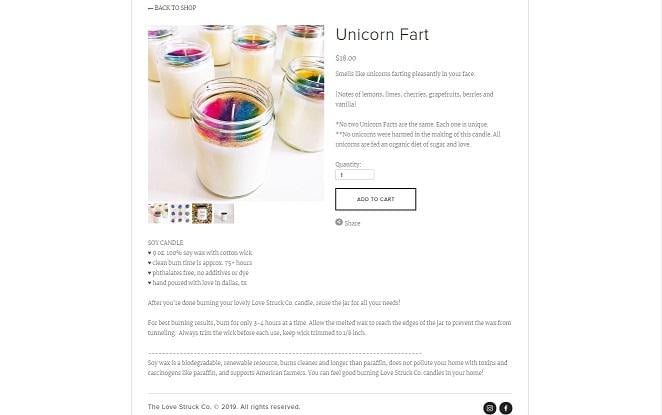
Via LoveStruckCo
Here’s the product description:
Smells like unicorns farting pleasantly in your face.
|Notes of lemons, limes, cherries, grapefruits, berries and vanilla|
*No two Unicorn Farts are the same. Each one is unique.
**No unicorns were harmed in the making of this candle. All unicorns are fed an organic diet of sugar and love.
(I promise I’m not five years old. #sorrynotsorry)
Take in this beauty of a description. It’s short. No words are wasted. It bursts with helpful information about how to use and care for the product. It doesn’t just list details about the ingredients (“phthalates free”), but explains why the buyer should care about this (“does not pollute your home…supports American farmers.”) And at its end, it leaves you with a feeling: “You can feel good burning Love Struck Co. candles in your home!”
Thank you, LoveStruckCo., for reminding us all that we can.
How to surprise and delight with your product descriptions
Grab pens and paper, a colleague, and a fun snack (not optional), and start brainstorming! Answer the following questions based on what you know about your customers:
- What do they expect from your product? How can you upend that expectation?
- If they won’t have any concrete expectations for your product, could you build expectation with the product title and then upend that expectation in the description?
- What would make them laugh? Is their humor silly, dry, ironic, or witty?
- What common memories or experiences might your customer base share? (This description from LoveStruckCo is a good example of this.) How can you trigger this memory?
- What would make your customer base compulsively “awwww,” cheer, or punch the air?
A product description checklist
If you remember anything from this blog post, remember this: Write product descriptions that serve your customers. Meet your customers where they are. Understand their needs. Provide accurate, thorough information that helps them make a smart purchase decision. Tell them a story that helps them imagine how this product would make their lives better. And give them a good laugh.
If you need a little more inspiration to get started, try answering these 10 questions:
- Who will buy and/or use this?
- What ordinary problems do they deal with on a daily basis? How could this product solve them?
- What makes this product different from other products on the market?
- What else might someone buy to solve their problem? What are they currently using, if anything?
- What makes this person happy? Afraid? Excited? Worried?
- What does this person value?
- What information, and how much, do they need to make a smart purchase decision?
- What can you do that would surprise them?
- What should your product make the buyer feel? How can your product description make them feel that without telling them to feel that?
- How can you ask your real customers directly what their needs and pain points are?
Got questions? Thoughts? A product description you’ve seen on the internet that you love? Post them in the comments below!



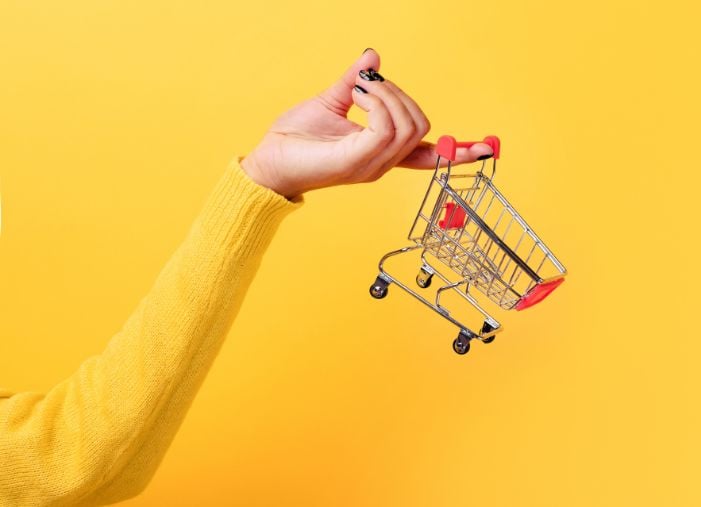
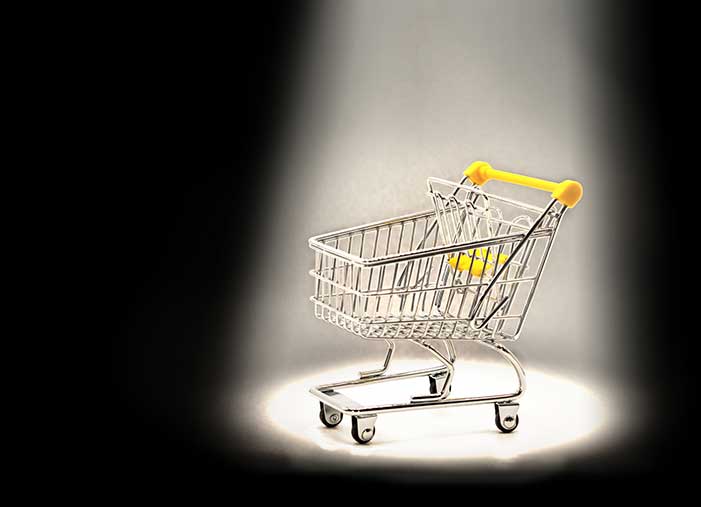


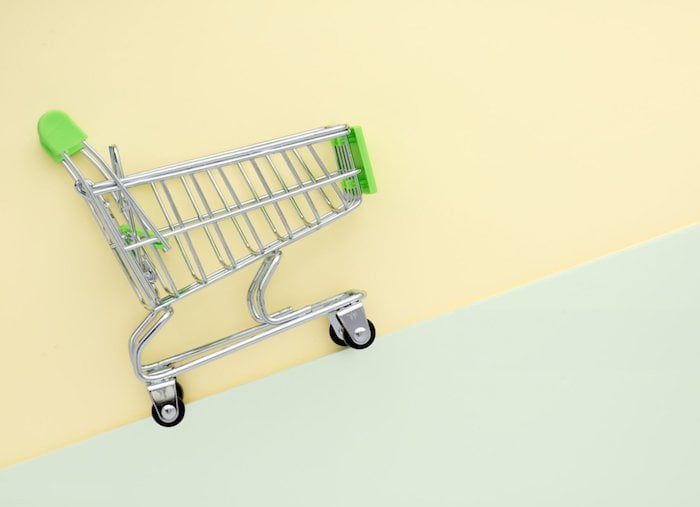

Comments
Please read our Comment Policy before commenting.